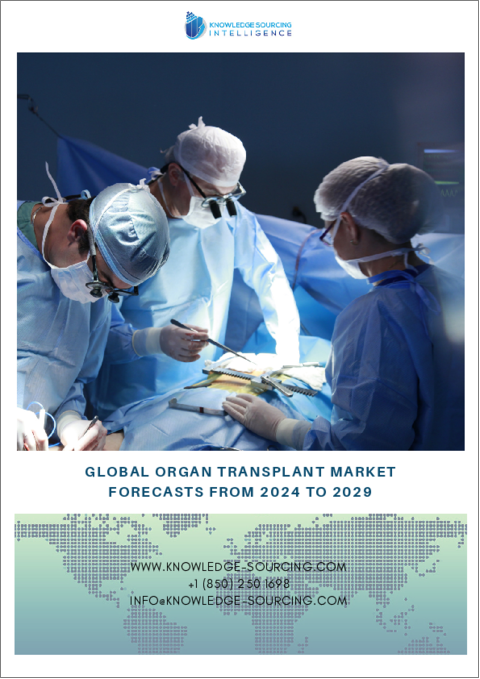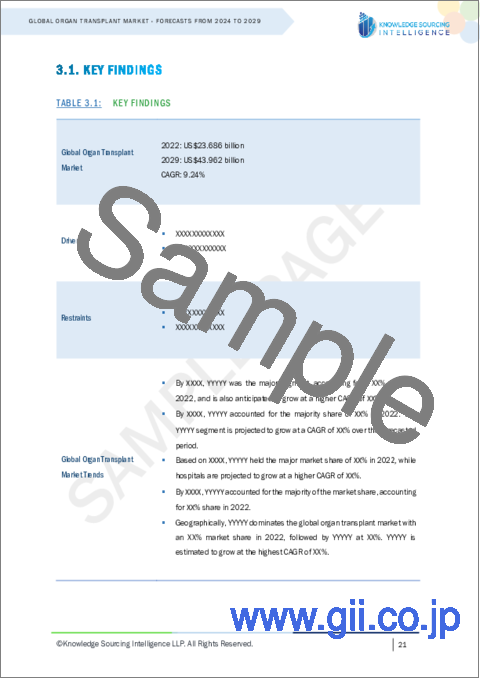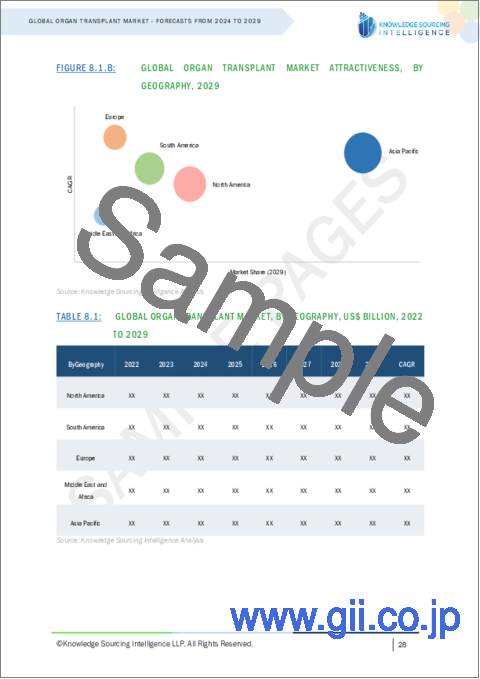|
|
市場調査レポート
商品コード
1086992
臓器移植の世界市場予測(2022年~2027年)Global Organ Transplant Market - Forecasts from 2022 to 2027 |
||||||
|
● お客様のご希望に応じて、既存データの加工や未掲載情報(例:国別セグメント)の追加などの対応が可能です。 詳細はお問い合わせください。 |
|||||||
| 臓器移植の世界市場予測(2022年~2027年) |
|
出版日: 2022年04月12日
発行: Knowledge Sourcing Intelligence
ページ情報: 英文 120 Pages
納期: 即日から翌営業日
|
- 全表示
- 概要
- 目次
世界の臓器移植の市場規模は、2020年に189億8,700万米ドルとなり、予測期間中に8.51%のCAGRで推移し、2027年までには336億3,100万米ドルに達すると予測されています。同市場拡大の主な要因は、臓器不全を治療するための革新的な組織移植製品および臓器移植のニーズが高まっていることです。
当レポートでは、世界の臓器移植市場を調査し、市場規模や予測、市場の促進要因および課題、市場動向、製品タイプ別・臓器の種類別・エンドユーザー別・地域別の市場分析、競合情勢、主要企業のプロファイルなどの体系的な情報を提供しています。
目次
第1章 イントロダクション
- 市場の定義
- 市場セグメンテーション
第2章 調査手法
- 調査データ
- 前提条件
第3章 エグゼクティブサマリー
- 調査のハイライト
第4章 市場力学
- 市場促進要因
- 市場抑制要因
- ポーターのファイブフォース分析
- 供給企業の交渉力
- バイヤーの交渉力
- 代替品の脅威
- 新規参入業者の脅威
- 競争企業間の敵対関係
- 業界のバリューチェーン分析
第5章 世界の臓器移植市場:製品タイプ別
- イントロダクション
- 臓器保存ソリューション
- 移植診断
- 組織製品
- その他
第6章 世界の臓器移植市場:臓器の種類別
- イントロダクション
- 心臓
- 腸
- 肝臓
- 肝臓
- 肺
- 膵臓
第7章 世界の臓器移植市場:エンドユーザー別
- イントロダクション
- 病院
- 移植センター
- その他
第8章 世界の臓器移植市場:地域別
- イントロダクション
- 北米
- 米国
- カナダ
- メキシコ
- 南米
- ブラジル
- アルゼンチン
- その他
- 欧州
- 英国
- ドイツ
- フランス
- イタリア
- その他
- 中東・アフリカ
- サウジアラビア
- イスラエル
- その他
- アジア太平洋
- 中国
- 日本
- インド
- 韓国
- インドネシア
- タイ
- 台湾
- その他
第9章 競合環境と分析
- 主要企業と戦略分析
- 新興企業と市場の収益性
- 合併、買収、合意、およびコラボレーション
- ベンダー競争力マトリックス
第10章 企業プロファイル
- OrganOx Limited
- GlaxoSmithKline Plc.
- Pfizer
- Organ Assist B.V.
- Paragonix Technologies Inc.
- Novartis AG
- Preservation Solution Inc.
- Water Medical System LLC
- Sanofi S.A
- XVIVO Perfusion AB
- Bridge to Life Ltd.
The global organ transplant market is projected to grow at a CAGR of 8.51% during the forecast period to reach US$33.631 billion by 2027, from US$18.987 billion in 2020.
A major element driving market expansion is the rising need for innovative tissue transplantation products and organ transplantation to treat organ failure. Organ failure can be caused by several reasons, including severe trauma, poor eating habits, excessive alcohol intake, poisoning, blood loss, drug misuse, and other acute disorders. Diabetes and high blood pressure, for example, are the most common causes of end-stage kidney disease, which requires a renal transplant or dialysis to keep a patient alive. The need for tissue and organ transplantation, particularly kidney, heart, liver, and lungs transplantation, is quite high worldwide. In 2019, around 122,913 people were waiting for organ transplants in the United States, according to the US Department of Health and Human Services.
The market is also being boosted by the launch of technologically improved products and an increase in the number of tissue banks. According to the US Department of Health and Human Services, 43,201 people in the US were waiting for kidney transplants in 2019, although only 23,401 kidney transplants were carried out. Furthermore, recipients are prescribed potent immunosuppressive medicines following transplantation surgery, increasing their susceptibility to infectious infections as their immune is reduced. Technological advancements in novel transplant products and methods by biotechnology and medical device companies and rising healthcare spending are expected to boost the market.
Another factor driving the market is an increase in the prevalence of acute diseases like diabetes and high blood pressure that lead to end-stage renal disease. According to the World Health Organization (WHO), the geriatric population will exceed 2 billion by 2050. Liver, lung and kidney failures, cardiovascular illnesses, and other conditions are becoming increasingly common as a result of the rising prevalence of chronic diseases. This is a significant factor driving organ care product demand. Cirrhosis is the eleventh largest cause of death globally, and liver cancer is the sixteenth leading cause of death, according to the European Association for the Study of Liver.
However, limitations, such as a scarcity of organ donors for transplantation and high costs, are projected to limit market expansion. The need for organ care is being hampered by the high expense of therapy. The lengthy clearance process for novel organ care products hinders the organ care market's growth. The market's expansion is being hampered by a scarcity of trained specialists in the organ care system. Transplanting a human organ is a very sophisticated surgery requiring outstanding abilities. Because there are so few surgeons in this field who can perform these types of procedures, the cost of this procedure is extremely high. This aspect can potentially stifle the expansion of the organ transplantation market significantly. Furthermore, the number of organ donors is insignificant compared to the number of persons who require such organs. Another key aspect that may stymie the expansion of the organ transplantation market is the rising incidence of organ failure.
Key Developments
In December 2021, Penn Medicine announced that it had received a seven-year, $14 million grant from the National Institutes of Health (NIH) to apply chimeric antigen receptor T-cell immunotherapies to identify and treat patients in need of kidney transplants. OrganOx Limited debuted its ground-breaking liver perfusion equipment in January 2019. It was also given the green light by the UK's National Institute for Health and Care Excellence.
By product type, the global organ transplant market can be segmented into organ preservation solutions, transplant diagnostics, tissue products, and others. The tissue products category is expected to dominate the market. The segment's growth is fueled by rising demand for transplant operations such as cochlear implants, orthopedic soft tissues, heart valves, and bone marrow.
By organ type, the global organ transplant market can be segmented into heart, intestine, kidney, liver, lung, and pancreas. Renal or kidney transplantation is the most prevalent type of organ transplantation worldwide. Although various treatments for end-stage renal disease, such as dialysis, are available, kidney transplantation is widely regarded as the best option.
By end-users, the global organ transplant market can be segmented into transplant centers, hospitals, and others. The hospital's category accounted for the greatest proportion owing to the significant number of organ and tissue transplant procedures performed at hospitals. However, due to the rising demand for healthcare facilities that cater to patients' unmet requirements and government programs encouraging organ donation, the transplant centers category is likely to increase over the projection period.
By geography, the global organ transplant market can be segmented into the Asia Pacific, North America, the Middle East and Africa, South America, and Europe. Over the projected period, the Asia Pacific region is expected to grow at the highest rate. The developing medical tourism in Asia Pacific countries such as India, the growing geriatric population in various nations, and the rising prevalence of congenital hydrocephalus in China are all factors driving revenue growth in this regional market.
COVID-19 Insights
Access to solid organ transplantation has been hampered by the COVID-19 epidemic. During the epidemic, the number of transplants performed decreased globally. The most afflicted organ transplants were kidneys, followed by the lungs, liver, and heart. COVID-19 had a global impact on transplantation, with a 31% decline in solid organ transplants conducted during the first pandemic wave compared to the previous year. Approximately 48,000 years of patient life were lost as a result of this deterioration.
Market Segmentation:
- By Product Type
Organ preservation solutions
Transplant diagnostics
Tissue products
Others
- By Organ Type
Heart
Intestine
Kidney
Liver
Lung
Pancreas
- By End-Users
Hospitals
Transplant Centers
Others
- By Geography
North America
- USA
- Canada
- Mexico
South America
- Brazil
- Argentina
- Others
Europe
- United Kingdom
- Germany
- France
- Italy
- Others
Middle East and Africa
- Saudi Arabia
- Israel
- Others
Asia Pacific
- China
- Japan
- India
- South Korea
- Indonesia
- Thailand
- Taiwan
- Others
TABLE OF CONTENTS
1. INTRODUCTION
- 1.1. Market Definition
- 1.2. Market Segmentation
2. RESEARCH METHODOLOGY
- 2.1. Research Data
- 2.2. Assumptions
3. EXECUTIVE SUMMARY
- 3.1. Research Highlights
4. MARKET DYNAMICS
- 4.1. Market Drivers
- 4.2. Market Restraints
- 4.3. Porter's Five Forces Analysis
- 4.3.1. Bargaining Power of Suppliers
- 4.3.2. Bargaining Powers of Buyers
- 4.3.3. Threat of Substitutes
- 4.3.4. Threat of New Entrants
- 4.3.5. Competitive Rivalry in Industry
- 4.4. Industry Value Chain Analysis
5. GLOBAL ORGAN TRANSPLANT MARKET, BY PRODUCT TYPE
- 5.1. Introduction
- 5.2. Organ preservation solutions
- 5.3. Transplant diagnostics
- 5.4. Tissue products
- 5.5. Others
6. GLOBAL ORGAN TRANSPLANT MARKET, BY ORGAN TYPE
- 6.1. Introduction
- 6.2. Heart
- 6.3. Intestine
- 6.4. Kidney
- 6.5. Liver
- 6.6. Lung
- 6.7. Pancreas
7. GLOBAL ORGAN TRANSPLANT MARKET, BY END-USERS
- 7.1. Introduction
- 7.2. Hospitals
- 7.3. Transplant Centers
- 7.4. Others
8. GLOBAL ORGAN TRANSPLANT MARKET, BY GEOGRAPHY
- 8.1. Introduction
- 8.2. North America
- 8.2.1. United States
- 8.2.2. Canada
- 8.2.3. Mexico
- 8.3. South America
- 8.3.1. Brazil
- 8.3.2. Argentina
- 8.3.3. Others
- 8.4. Europe
- 8.4.1. United Kingdom
- 8.4.2. Germany
- 8.4.3. France
- 8.4.4. Italy
- 8.4.5. Others
- 8.5. Middle East and Africa
- 8.5.1. Saudi Arabia
- 8.5.2. Israel
- 8.5.3. Others
- 8.6. Asia Pacific
- 8.6.1. China
- 8.6.2. Japan
- 8.6.3. India
- 8.6.4. South Korea
- 8.6.5. Indonesia
- 8.6.6. Thailand
- 8.6.7. Taiwan
- 8.6.8. Others
9. COMPETITIVE ENVIRONMENT AND ANALYSIS
- 9.1. Major Players and Strategy Analysis
- 9.2. Emerging Players and Market Lucrativeness
- 9.3. Mergers, Acquisition, Agreements, and Collaborations
- 9.4. Vendor Competitiveness Matrix
10. COMPANY PROFILES
- 10.1. OrganOx Limited
- 10.2. GlaxoSmithKline Plc.
- 10.3. Pfizer
- 10.4. Organ Assist B.V.
- 10.5. Paragonix Technologies Inc.
- 10.6. Novartis AG
- 10.7. Preservation Solution Inc.
- 10.8. Water Medical System LLC
- 10.9. Sanofi S.A
- 10.10. XVIVO Perfusion AB
- 10.11. Bridge to Life Ltd.




